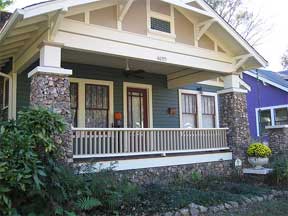With the profusion of horrible, or at best trite, examples of doorway plantings to be seen at every glance, there is no intention on my part to cite the wrong things to do in landscaping these areas. While it may be true that we learn from a bad example, I have no intention of rubbing salt in an already open wound.
The doorway of almost any home is the most prominent feature of the facade. Almost equally true is the fact that the door, by reason of its location, becomes a prime feature of the landscape scheme of any property.
Family, visitors and strangers passing by see this important landscape feature more than any other. If we will recognize this fact, then it is time to delve into the simple solutions which present themselves.
Doorways need to be inviting in order to be in keeping with our mode of living. Every attempt should be made to make the doorway seem friendly. Since the entrance to the home is the first real contact which a visitor has with the resident, this feeling of friendly invitation becomes increasingly important.

Hand in hand with the invitation offered by a handsome entrance is the feeling of comfort which can come from a well placed shade tree or canopy to shield from sun and rain. A feeling of protection from the elements is further evidence of friendship proffered by the resident.
Changing During the Seasons
Seasonal attraction, whether it be the cheery brightness of yellow daffodils in the spring or the brilliance of mums in the fall, can be a healthy stimulus to the well-being of the visitor, be he a bill collector or a close relative. The sudden flutter of a startled cardinal or nesting robin in a nearby evergreen is a sure way to waken us again to the wonders of nature.
The fourth consideration comes under the heading of easy maintenance. Certainly a well thought out scheme is no better than its practical application. The prospect of a hard clean-up job in the garden is not tempting to the weary office worker home for the day.
Several themes of doorway planting present themselves for consideration— the intimate or garden type of planting which provides a great deal of interest or the more expansive planting which tends to enhance and frame the door area, and the informal or unbalanced planting which easily combines features of the first two types.
For example, the use of a fence (white board, post and rail, or other) effectively provides both interest and a widening effect to the front picture. Several considerations mentioned above are combined here. The shade tree, flowering materials, and easy-to-maintain ground covers all merit thorough study.
Another example takes advantage of the symmetrical use of materials with a feeling of informality achieved through the use of informal plant materials.
For an informal appearance can be achieved by the free form layout of a front bed area combined with plants which carry out the informality. The semi-formal arrangement between walk and house can be justified by the window arrangement. An important point to be recognized is the possibility of easy and effective use of accessory materials such as tubs or pots, boulders and lamp posts. Interest is the keynote of any planting. Certainly plant materials can be enhanced by judicious use of these accessories.
A great deal has been written and spoken about keeping plantings in scale with a certain style of architecture, and along with this keeping them in accord with the style. This, of course, has many too many aspects to delve into here.
There is no set rule. Consider the architecture but do not necessarily be bound by it. Every example should be treated independently and a sincere effort made to enhance the architecture.
